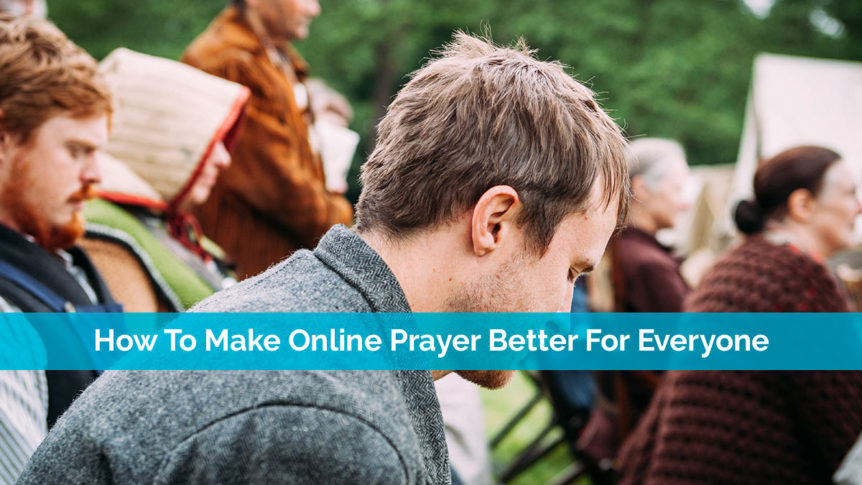If you already offer it on your website, you may be wondering how to make online prayer better.
Of course, if you don’t offer it on your church’s site or app, you might not even realize this type of prayer is a real thing. We covered this before and even explained how it’s beneficial to growing your church.
Simply having an open forum or a form without any real feedback isn’t enough. Give your members and site visitors much more from your online prayer feature.

Explain How It Works
This one might not seem all that important, but remember, for many people this is their first time trying online prayer. Plus, every church and prayer service works differently.
In fact, 82% of Americans who pray typically pray quietly by themselves. Putting a prayer request online or responding to one is a major change.
At the top of your online prayer page or as a menu item in your church app, explain how your prayer system works. Will users get to see others’ prayers? Where do the prayers go? Who responds to them, if anyone? How does someone submit a prayer request?
Think of it as explaining a new app. Give them the background they need to successfully use your system.
Offer Named & Anonymous Prayer Requests
Sometimes, people don’t want anyone to know who’s requesting a prayer. For instance, a church member who recently found out they have cancer might not want to publicly announce it just yet. However, they’d love to know that others are praying for them to get better.
While users could give fake names, an anonymous option ensures they don’t accidentally use a name too close to their own. Besides, they may not want to lie about their name by coming up with a new one.
You can also use an initials only system or first name last initial system for adding and responding to prayers.
Provide Prayer Tips
To truly make online prayer better, offer online prayer tips. It’s easy to believe your members pray often, but someone new to your website may be praying for the very first time. They might have experienced a tragedy recently that’s resulted in them exploring their faith.
Have a section on your online prayer page with tips for more effective prayers, such as:
- Speak directly to God. Don’t just type your prayer, but say it aloud or internally to God.
- Pray for what’s bothering or burdening you versus general prayers. Both are effective, but specific prayers tend to work best.
- Pray for what’s truly important. For example, praying for a favorite sports team to win isn’t the most effective use of prayer.
- Be thankful. This includes being thankful to God for listening and even saying thank you to those who say they’re praying for you.
- Ask for forgiveness. If someone’s burdened by a regret or mistake, suggest they explain what happened and ask for forgiveness.
- Remind users it’s okay to prayer for the little things. You don’t have to just wait until it’s something big, such as a sick loved one.
- Keep a prayer journal. Online prayer works well, but suggest that people have a prayer journal to explore their prayers more in-depth. They can even list the other people’s prayers whom they’re praying for too.
There isn’t really a right or wrong way to pray. Above all else, ensure people know this and that includes your members. Praying out loud in the kitchen while cooking breakfast is just as meaningful as praying quietly right before bed.

Provide Private Prayer Options
For some users, the best way to make online prayer better is to offer private prayer options. Even with anonymous posting, they might not be comfortable putting their prayer online for everyone to see.
In this case, have a few church staff respond directly to private prayers. These would be sent to a specific email address instead of posting publicly.
Please note how long it may take to respond so people know they’re not being ignored. Since prayers can come in day or night, try to get several staff members involved in checking for and respond to prayer requests.
Employ Moderators
Sadly, some people may try to abuse your online prayer system. They may respond negatively to other users or post highly inappropriate content.
While you can have your church website filter certain things, some stuff may still get through. Have a team of moderators in place to constantly check for and remove inappropriate content. Teach your moderators how to block IP addresses and users to aid in keeping your system clean and safe for everyone.
Moderators can be a team of volunteers from your church or even online members who use your church’s site often, but can’t physically attend your church. You could also employ the same staff members who respond to private prayer requests.
Offer Daily Devotional Prayers
Some users may not have a specific prayer in mind. They may just come to view the prayers of others and pray for them. To help guide them in their daily prayers, which is the frequency that 55% of praying Americans pray, provide daily devotional prayers.
This can be a feature you update daily near the top of your online prayer page. Or, it could be in a forum format so new visitors can go back and look at previous daily devotional prayers.
Another option is to use your church’s blogs for daily devotionals, including prayers. Simply link to your blog from your prayer page. Doing it as a blog post gives you more room to get in-depth on the devotional. However, if you’re doing this, you may find it more effective to only post a new one a few times a week, especially if you’re already crunched for time.
Implement A Prayer Chat
Wouldn’t it be nice if everyone could talk about their prayers in real-time? If you have enough users, this could be a reality with a prayer chat feature.
Much like Facebook Messenger, have a chat/messaging feature on your church’s prayer page. This makes online prayer better by giving users someone to talk to. They know they’re not alone in what could be some people’s darkest moments.
If you’re still growing your church website, you may not have enough users yet to keep the chat feature active. As an alternative, ask a few volunteers to be available for chat during certain hours. List these hours on your website.
As the popularity of your site and online prayer feature grow, you may quickly find you have an active prayer community.
Send Prayer Notifications (For Church Apps)
While you can ask to send users notifications from your website, you’ll typically be doing this from your church app. You should have several different types of notifications to keep users coming back to your app. A few ideas include:
- Notifying users of new prayer requests.
- Notifying users of any responses to their prayer requests.
- Asking them to check out today’s daily devotional.
- Reminding them when the chat feature is live.
- Reminding them to pray at a certain time. This would be a feature they can set up that works much like a daily planner. The app notifies them to pray at the time they previously set.
Notifications are completely optional, but can be highly effective at keeping users and even your members engaged. Make sure that you make notifications optional for users so they don’t avoid using your app.

Explain The Importance Of Prayer
Prayer isn’t always something that makes sense to people. Even your members may have a hard time understanding why they should pray outside of weekly services.
It’s a good idea to explain the purpose behind prayer. Talk about the connection it helps to build with God. Mention the benefits, such as reducing stress by giving burdens to God and having faith He’ll carry them.
Of course, scripture about praying makes online prayer better by showing what the Bible has to say about prayer. A few lists of scripture regarding prayer include:
- Bible Study Tools – 40 Prayer Bible Verses
- Crosswalk – 10 Bible Verses About Prayer
- CBN – 5 Scriptures That Will Redefine Your Prayer Life
A fun way to showcase scripture is by using a slider or carousel effect. Pick your favorite verses and let them rotate for users to see.
Host Weekly Live Prayer Sessions
This one might not be possible for all churches, but it does make online prayer better by letting people prayer together in real-time. Each week, stream your pastor or another church leader leading a prayer session.
This can be 30 minutes or even a few hours. You could also host several live streams at different times each week to offer more opportunities for people to join in. If you have the chat feature enabled, engage with participants and answer questions.
At the end of each session, have a moment of silence for everyone to prayer for what’s weighing on them. For many, this feels more like church and makes praying easier. It also takes away much of the stigma around online prayer feeling disconnected.
Allow Social Sharing
It may seem like everything is social now. You wouldn’t really be wrong, honestly. Even online prayer is a social thing. When someone posts a prayer, give them the option to share it to social media.
One thing to note is you should only allow them to share their own prayers. Others may not want their prayers posted to Facebook, Twitter or other networks. You may even want to incorporate a fail safe on your site to prevent anyone from taking screenshots. This won’t stop them from taking an actual picture, but it will deter many people.
Social sharing also brings more people back to your site, who will then utilize your online prayer feature. This helps boost your prayer chat feature faster.

Organize Prayer Requests
Have you ever stored all your important papers in one box without any type of organization? It’s impossible to find what you need. The same goes with prayer requests.
Instead of just an endless list or a forum where all prayers are lumped together, create a forum or category option to organize prayers. While you can have a general category, also list things like illness, death, financial stress, children and so on.
Another idea is to add a search feature. This makes it much easier to find specific types of prayers and find others who may be going through the same things.
This creates a more engaging experience and helps make online prayer better.
Display A Prayer Guide
After you’ve categorized prayer requests, it’s beneficial to provide prayer guides for each category. These guides list some of the most common things people pray for in each category.
The guides also provide suggestions on how to pray for certain things. For instance, instead of praying for world peace, the guide might suggest praying that a current conflict between two countries be resolved peacefully, leading to a more peaceful world.
While you don’t have to have prayer guides, they can be useful, especially for those new to prayer. Offering guidance also makes users feel more like a pastor is guiding them through their prayer journey.
Allow For Prayer Updates
Finally, offer closure to users. Nothing is more frustrating than feeling a deep attachment to someone’s prayer but not knowing how it turned out. For example, if someone is requesting prayers about a sick relative, they want to know if everything’s okay now.
Obviously, prayer updates will depend solely on the original requester coming back to post the update, but the option should be available. Ensure moderators are in place to remove any negative responses for users who are being impatient about updates.
Not only does this provide closure, but it encourages users to keep coming back. Remember every user that this is indeed optional, but request that they please give updates to those who are praying for them. This also makes the entire online prayer system more social.
Interested in adding an online prayer system to your church website? Contact our team today to learn how we can help.





Comments 3
I struggle with anxiety, fear torment during certain seasons, especially the last 5 months. Prayer for the uncovering and binding of the root cause and loosing and releasing of the peace of the Lord
Pray for dake and tyke and contact them on instagram
Thanks a lot for the tips on praying online. I am leading a prayer chain in whatsapp during this covid-19 season and the information is very useful.